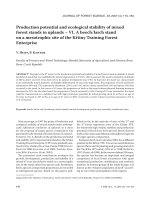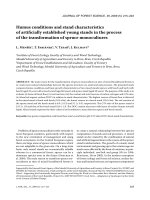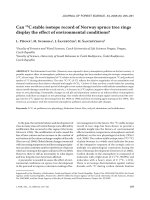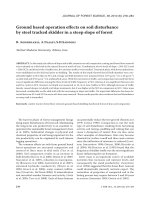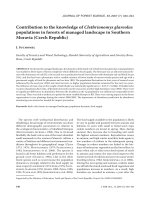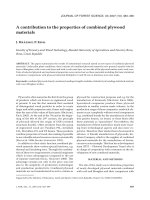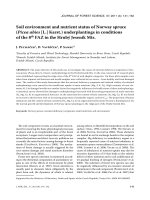Báo cáo lâm nghiệp: "A pheasantry as the habitat of small terrestrial mammals (Rodentia, Insectivora) in southern Moravia (Czech Republic)" doc
Bạn đang xem bản rút gọn của tài liệu. Xem và tải ngay bản đầy đủ của tài liệu tại đây (381.44 KB, 8 trang )
J. FOR. SCI., 53, 2007 (4): 185–191 185
JOURNAL OF FOREST SCIENCE, 53, 2007 (4): 185–191
Pheasantries represent a specific biotope for free-
living higher vertebrates characterized by the high
diversity of sites, high concentration of pheasants
and high amount of supplementary food in the form
of feeding for pheasants. Moreover, in the region of
southern Moravia, pheasantries represent isolated
areas of woody vegetation in the middle of intensive-
ly managed landscape. In addition to intensive game
keeping, they can serve as refuges for a number of
animals. Without these specific properties the areas
would be other isolated forest units in the cultivated
landscape, the fauna of which has already been stud-
ied intensively and described (D, Š
1983; M 1985; P 1986, 1989; T et
al. 1990; Y et al. 1991; S 1994; S,
M 1995; S et al. 1996; S,
H 2004, etc.). However, pheasantries as
specific habitats of small mammals have not been
studied yet. Nevertheless, some papers dealt with
other vertebrates, e.g. birds (K et al.
1992). e presented study of the synusiae of small
terrestrial mammals of pheasantries in southern
Moravia is therefore aimed at monitoring the effect
of specific properties of these habitats (high diversity
of biotopes, high concentration of pheasants, feed-
ing supply – form of feed) on the diversity of the
community of small terrestrial mammals and on the
abundance and viability of their populations.
Area of study
Two pheasantries were selected for the study, the
one intensive and the other extensive, both of them
with similar environmental conditions.
Supported by the Ministry of Education, Youth and Sports of the Czech Republic, Project No. MSM 6215648902, and the Czech
Science Foundation, Project No. 526/03/P051.
A pheasantry as the habitat of small terrestrial
mammals (Rodentia, Insectivora) in southern
Moravia (Czech Republic)
J. S
1
, M. H
2
1
Faculty of Forestry and Wood Technology, Mendel University of Agriculture and Forestry Brno,
Brno, Czech Republic
2
Institute of Vertebrate Biology, Academy of Science of the Czech Republic, Brno, Czech Republic
ABSTRACT: Communities of small terrestrial mammals were studied in the specific environment of two pheasantries
in southern Moravia with different intensity of pheasant management and different diversity of biotopes (RB – inten-
sive pheasantry, HJ – extensive pheasantry). In total, ten species from the order Rodentia and Insectivora were found
there in 2002–2005. e rodents Apodemus flavicollis, A. sylvaticus and Clethrionomys glareolus dominated in these
habitats. On the other hand, the populations of insectivores were very low, Crocidura leucodon and C. suaveolens be-
ing interesting species. RB with the higher variety of biotopes showed significantly higher diversity (P < 0.05) of small
mammals (H´ = 1.284, ten species determined) than HJ (H´ = 1.112, five species determined). e higher intensity
of management (the amount of chickens released per unit area and the amount of served food) in RB compared to
HJ was not reflected in the relative abundance of the community of small terrestrial mammals (rA in RB = 11.82, in
HJ = 11.85) nor in their evenness (E). e probability of difference was P > 0.05. A difference in the diversity of compared
communities was conditioned by different diversity of biotopes.
Keywords: pheasantry; diversity; small terrestrial mammals
186 J. FOR. SCI., 53, 2007 (4): 185–191
e locality Rumunská – RB (280 ha) – (49°02.41´N,
16°42.8´E) situated near the town of Židlochovice at
an altitude of 190 to 200 m above sea level is used as
an intensive pheasantry. e intensive management
of Phasianus colchicus and Syrmaticus reevesi is
carried out there. With regard to microhabitats, the
Rumunská locality is the most variable area of them.
It includes a number of miscellaneous woody species
of various age categories as well as small open areas,
such as meadows, small fields, and wetlands. Pedun-
culate oak (Quercus robur), sessile oak (Q. petraea),
Scots pine (Pinus sylvestris), Norway spruce (Picea
abies), and black poplar (Populus nigra) are domi-
nant woody species in this locality. e following
groups of forest types were identified there: Ul-
meto-Fraxinetum carpineum, Saliceto-Alnetum and
Carpineto-Quercetum acerosum. As to the shrub
and herb stratum, a great variety of species occurs
there. In Ulmeto-Fraxinetum carpineum, Sambucus
nigra and Crategus laevigata are dominant and also
some young specimen of trees occurred. In the herb
stratum, Urtica dioica, Galium aparine, Symphytum
officinale, Carex acutiformis, Carex riparia, Gle-
choma hederacea, Rubus caesius and Deschampsia
caespitose are dominant. In Saliceto-Alnetum, there
is a rich shrub layer dominated by Salix caprea and
Sambucus nigra with a herb layer of Aegopodium
podagraria, Galium aparine, Stachys sylvatica,
Urtica dioica, Impatiens noli-tangere, Equisetum
sylvaticum, Deschampsia cespitosa, Cardamine am-
ara. In Carpineto-Quercetum acerosum, the highest
dominance of Acer campestre and young specimens
of the tree stratum was recorded with Alliaria of-
ficinalis, Veronica hederifolia, Lapsana communis,
Urtica dioica and Aristolochia clematis as dominant
species in the herb stratum. ere were two lines of
traps led in a trees cropping mast oak forest, one line
in a young oak stand, one in a spruce forest, one in
a pine forest and one at a forest edge. As to sample
the particular forests, trapping lines were led in all
characteristic types of stands. e number of pheas-
ants released every year amounts to 72 birds/ha
(F, personal communication 2002).
The locality Hájek – HJ(60 ha) – (48°57.4´N,
016°35.62´E) is a typical production forest and exten-
sive pheasantry, characterized by the group of forest
types Carpineto-Quercetum acerosum. It is situated
near Vranovice at an altitude of 190 m above sea
level. Pedunculate oak (Quercus robur), sessile oak
(Q. petraea), and black locust (Robinia pseudoaca-
cia) are dominant woody species. In the shrub layer,
Sambucus nigra and some young specimens of trees
such as black locust (Robinia pseudoacacia) and
pedunculate oak (Quercus robur) occur. e most
frequent species of the herb stratum are grasses
(Poales) and some species such as Viola sp., Geum
urbanum, Alliaria officinalis, Pulmonaria officinalis,
Galium sp., Lamium sp., Stachys sylvatica, Stelaria
nemorum, Ranunculus sp., Ficaria verna, Rumex sp.
ere were two lines of traps led in a trees cropping
mast oak forest, one line in a mixed forest (Quercus
sp., Tilia sp., Carpinus sp., Acer sp.), one in a locust
stand and one at an oak forest edge. Each line con-
sisted of 20 snap traps, the line being about 100 m
long. e number of pheasants released every year
amounts to 15 birds/ha (F, personal com-
munication 2002).
MATERIAL AND METHODS
e study was carried out in 2002 to 2005. Small
mammals were sampled using the standard method
of line trapping by means of snap traps (P
1975) and combinations of snap and fall traps laid
in the shape of Y (Ř et al. 1998). Traps in lines
were laid by twenty, 5 m apart, the line length was
100 m. A kerosene lamp wick parched in oil and
flour or smeared with peanut butter was used as a
bait. Trap systems of the Y shape consisted of 10 fall
traps buried into the soil about 5 m apart, always
three in each of the arms and one trap at the place
where the arms meet. Two-litre plastic bottles with
cut-off necks were used as fall traps. In addition, one
snap trap was laid to each of them. Along the traps,
a firm foil was stretched to direct small mammals to
traps. Trapping was carried out five times a year in
the interval of about two months, from the end of
February to the beginning of November. One trap-
ping operation took three nights.
Caught small mammals were then identified in a
laboratory to determine the species, sex, sex activity,
and basic body dimensions were measured. ese
data provided information on the character of the
studied community.
e following basic ecological characteristics were
monitored:
Shannon-Weaver index of species diversity (S-
, W 1963)
n
i
n
i
H´ =
Σ
(
–––
)
× log
2
(
–––
)
n n
equitability (S 1969)
H´ H´
E = –––––– = ––––– ––
H´
max
log
2
S
and relative abundance (rA) and dominance (D) cal-
culated according to L et al. (1985).
J. FOR. SCI., 53, 2007 (4): 185–191 187
Results were statistically evaluated by a t-test for
separate samples in Statistica Cz 6.1. Program.
RESULTS
In the course of the study, in total 1,745 small
mammals of ten species were caught. Of them, seven
species of the order Rodentia and three species of
Insectivora.
Apodemus flavicollis (n = 924; D = 53%), A. syl-
vaticus (n = 342; D = 19.6%) and Clethrionomys
glareolus (n = 328; D = 18.8%) ranked among the
most numerous (eudominant) species being fol-
lowed by dominant Microtus arvalis (n = 132;
D = 7.6%) and sub-recedent M. subterraneus (n = 5;
D = 0.3%), Apodemus microps (n = 5; D = 0.3%), Sorex
araneus (n = 3; D = 0.2%), Crocidura leucodon (n = 3;
D = 0.2%), Mus musculus (n = 2; D = 0.11%) and
Crocidura suaveolens (n = 1; D = 0.06%).
On both plots, species of the genus Apodemus and
C. glareolus markedly predominated. In RB, all spe-
cies of the community of small terrestrial mammals
were found thanks to the local variety of microsites.
In HJ, all species of insectivores are missing. e
absence of Crocidura spp. and M. musculus and
A. microps shows obviously proves the absence of
suitable open and synanthropic sites (Table 1).
Differences in the relative abundance of small mam-
mals in both localities were small (RB, rA = 11.82%;
HJ, rA = 11.85%; see Fig. 1) and the difference
Table 1. Values of dominance (D), relative abundance (rA), diversity (H´) and equitability (E) of particular species of small
mammals determined on studied plots (∑, n – total number of caught mammals, PN – number of trapping nights)
Species
Hájek Rumunská
n D (%) rA (%) n D (%) rA (%)
Apodemus flavicollis 379 58.9 7.02 545 49.1 5.8
Apodemus sylvaticus 122 19 2.3 220 19.8 2.35
Apodemus microps 0 0 0 5 0.45 0.05
Mus musculus 0 0 0 2 0.18 0.02
Clethrionomys glareolus 89 13.8 1.65 239 21.5 2.56
Microtus arvalis 48 7.47 0.89 84 7.56 0.9
Microtus subterraneus 2 0.31 0.04 3 0.27 0.03
Sorex araneus 0 0 0 3 0.27 0.03
Crocidura leucodon 0 0 0 3 0.27 0.03
Crocidura suaveolens 0 0 0 1 0.09 0.01
∑ 640 1.105
PN 5.400 9.350
H´ 1.112 1.284
E 0.691 0.558
0
5
10
15
20
25
30
35
II/III
VI/VII
X/XI
IV/V
VIII/IX
II/III
VI/VII
X/XI
IV/V
VIII/IX
RA (%)
HJ
RB
II/III
IV/V
VI/VII
VIII/IX
X/XI
II/III
IV/V
VI/VII
VIII/IX
X/XI
II/III
IV/V
VI/VII
VIII/IX
X/XI
II/III
IV/V
VI/VII
VIII/IX
X/XI
2002 2003 2004 2005
Years
Fig. 1. Relative abundance of small mam-
mals in studied pheasantries
RA (%)
188 J. FOR. SCI., 53, 2007 (4): 185–191
between both pheasantries was not significant
(P > 0.05). During the four years of study rA in both
populations markedly fluctuated (Fig. 1).
In addition to total diversity (Table 1), diversity
was also calculated for the particular trapping peri-
ods during the four years of observation and within
the period it fluctuated considerably (from 0.16 to
1.53, see also Fig. 2). However, its mean values were
significantly higher in RB (H´ = 1.0054 ± 0.254773)
than in HJ (H´ = 0.788850 ± 0.349211). Generally,
diversity in RB was significantly higher than in HJ
(t = 2.240878; P = 0.030957).
e equitability of communities of small mammals
of both pheasantries does not differ significantly
(P > 0.05; α = 0.05) and its mean values are virtually
identical both in RB (E = 0.760900 ± 0.123530) and
HJ (E = 0.756070 ± 0.282048).
In addition to common species of rodents occur-
ring as important pests of forest and agricultural
production, RB provided also conditions for the
existence of threatened species, particularly of Cro-
cidura leucodon (according to the Regulation No.
395/1992 Acts).
DISCUSSION
Intensive pheasantries (in our case RB) are very
suitable habitats for a number of forest and steppe
species of small terrestrial mammals with respect to
the high diversity of biotopes. is mosaic character
is purposeful there, exactly corresponding to site
requirements of pheasants Phasianus colchicus and
Syrmaticus reevesi as forest-steppe species of birds
(H, Š 2005). e local diversity of small
mammals is therefore relatively high approaching the
sites that are relatively rich in small mammal species
in agrocoenoses. It applies e.g. to small groves and
windbreaks where diversity can be even a little high-
er than that found in the pheasantry (e.g. H´ = 1.5;
S, H 2004) or to small forest
tracts where diversity is similar (e.g. H´ = 1.14;
S et al. 1996). On the contrary, pheasantries
of the character of a commercial forest (here HJ)
are substantially poorer in habitats, which is also
reflected in the lower diversity of small terrestrial
mammals (HJ = 1.112, RB = 1.284) resembling other
woody formations in the cultural landscape (P-
1989; Z 1976, 1991). Lower diversity of
small terrestrial mammals in forest ecosystems of
southern Moravia was found only in floodplain for-
ests where it was gradually reduced owing to changes
in the water regime in the landscape after 1972 (from
H´ = 1.04 to H´ = 0.97; Z 1991) and after the re-
peated introduction of artificial floods it did not in-
crease yet (H´ = 0.87; S, H 2004).
In spite of the importance of pheasantries as re-
fuges for small mammals including threatened spe-
cies these are disturbed or anthropically influenced
sites (from the aspect of ecosystem stability), which
is demonstrated by the occurrence of several eudo-
minant and a number of subrecedent species (L
et al. 1985). As for dominant species, pheasantries are
suitable particularly for forest species, e.g. field mice
of Apodemus spp. which are highly adaptable and
even relatively small areas of woody vegetation, e.g.
windbreaks, are enough for their survival (P
1986; S 1994; S, M 1995).
ese sites are however unsuitable for a number of
0
0.4
0.8
1.2
1.6
II/III
VI/VII
X/XI
IV/V
VIII/IX
II/III
VI/VII
X/XI
IV/V
VIII/IX
H ´
RB
HJ
II/III
IV/V
VI/VII
VIII/IX
X/XI
II/III
IV/V
VI/VII
VIII/IX
X/XI
II/III
IV/V
VI/VII
VIII/IX
X/XI
II/III
IV/V
VI/VII
VIII/IX
X/XI
2002 2003 2004 2005
Years
Fig. 2. Diversity of small
terrestrial mammals in two
differently managed pheas-
antries (RB, HJ) in the ru-
ral landscape of southern
Moravia
H´
J. FOR. SCI., 53, 2007 (4): 185–191 189
steppe species such as voles M. arvalis (Z et
al. 2001). erefore, the dominance of voles in wind-
breaks is low (D = 6%) (P 1986) and consider-
ing similar values from pheasantries (about 7%, see
Table 1) both types of sites are obviously unsuitable
for voles. Extensive isolated forest tracts are even less
suitable biotopes for voles of the genus Microtus than
windbreaks and pheasantries (D = 2.4%; S,
H 2004) and large closed forest units, e.g.
floodplain forests (Z 1991).
These pheasantries were also characterized by
their very low abundance of insectivores from the
family Soricidae, which was evidently related to
their general decrease in Moravia during the stud-
ied period (Z, personal communication). It
became particularly evident in the genus Sorex, in
the sporadic trapping of S. araneus and surprising
absence of S. minutes, which is otherwise distributed
throughout the region (A 2000). At this time,
the abundance of shrews was very low even in flood-
plain forests (D = 2.6%) (S, H
2004). e higher dominance of Soricidae (14.7%)
was mentioned by Z (1976) in flooded forests
at the end of the 60s, however, in the 80s their
considerable fall to 1.08% occurred (S. a.) in this
biotope. is fall was probably caused by changes
in the water regime in floodplain forests after 1972
(Z 1991). e general decrease of Soricidae in
southern Moravia during the last 40 years was obvi-
ously caused by changes in the agricultural landscape
(Z 1996).
e study of small mammals of pheasantries also
brought supplementary information on the occur-
rence and distribution of Crocidura suaveolens, the
find of which in this region (maping square 6,966)
has not been published yet (A 2000). e
locality corresponds to its occurrence in warmer
regions of southern Moravia with the forest-steppe
vegetation of secondary character (G et al.
1996), however, the specimen found occurred in an
atypical wetland biotope in the growth of reed at
a water reservoir (R et al. 1997). is occur-
rence supports an opinion that although it is mainly
a synanthropic species (P et al. 1983) it is
able to colonize isolated buildings (which occur e.g.
in RB) by natural migration and not only through
importation with feed as supposed earlier (A
2000).
High concentrations of pheasants are an important
factor that could potentially affect populations of
small terrestrial mammals in pheasantries. How-
ever, pheasants are only marginal predators of small
terrestrial mammals (B et al. 1959; H,
Š 2005), and under conditions of this country
only domestic fowl can markedly contribute to the
local reduction of rodents. However, with respect
to their high concentrations in pheasantries pheas-
ants could have a marked effect at least theoretically
because they resemble populations of domestic fowl
by their high abundance and independence from
natural conditions. B et al. (1959) stated that
unlike free-living birds just poultry breeding could
affect populations of small mammals (e.g. field mice)
thanks to high concentrations of birds per unit area.
However, based on our results, this was not the case,
evidently on the ground of minor preference of small
mammals in food than in domestic fowl (B et al.
1959) and also thanks to intensive additional feed-
ing and perhaps also due to changes in the ethology
of artificially reared animals. Pheasants could also
cause some losses in trapped animals due to the pick-
ing of traps (however, it was never possible to prove
the trap was picked just by a pheasant). Neverthe-
less, populations of rodents were not significantly
affected.
Potential food supply in the form of feed for pheas-
ants (e.g. cereals) is a characteristic feature of pheas-
antries. Cereals can serve as food mainly in winter,
contributing to the successful survival of small mam-
mals (S et al. 2005). In the course of the
growing season when there is a sufficient amount of
natural food, feed for pheasants is not the main food
source for small animals and, their populations can
develop quite independently of it. is idea also ap-
pears to be supported by the development of studied
populations in both pheasantries. e relative abun-
dance of the populations was roughly the same both
in RB with intensive additional feeding (RA = 11.82)
and in HJ (RA = 11.85) where, owing to the much
lower number of pheasants, it is possible to suppose
a considerably smaller amount of served feed.
R e f e ren c e s
ANDĚRA M., 2000.
Atlas rozšíření savců v České republice.
Předběžná verze. III. Hmyzožravci (Insectivora). Praha,
Národní muzeum: 108.
BALÁT F., FOLK Č., HAVLÍN J., HUDEC K.,
1959. Myšilovní
ptáci, hubící hraboše polního v Československu. In.: KRA
-
TOCHVÍL J. et al., 1959. Hraboš polní (
Microtus arvalis).
Praha, ČSAV: 250–275.
BRYJA J., ZUKAL J.,
2000. Small mammal communities
in newly planted biocorridors and their surroundings in
southern Moravia (Czech Republic). Folia Zoologica, 49:
191–198.
DUDICH A., ŠTOLLMAN A.,
1983. Micro-mammal com-
munities in the tree species formation of the East Slovakian
Lowlands. Ekológia (Bratislava), 2: 353–373.
190 J. FOR. SCI., 53, 2007 (4): 185–191
GAISLER J., ZUKAL J., NESVADBOVÁ J., CHYTIL J.,
OBUCH
J., 1996. Species diversity and relative abundance
of small mammals (Insectivora, Chiroptera, Rodentia) in
the Pálava Biosphere Reserve of UNESCO. Acta Societatis
Zoologicae Bohemicae, 60: 13–23.
HUDEC K., ŠŤASTNÝ K.
(eds.), 2005. Fauna ČR. Ptáci 2/I.
Praha, Academia: 572.
KALIVODOVÁ E., ŠTEFUNKOVÁ D., DAROLOVÁ A
.,
1992. Ecological evaluation of the pheasantry in Jahodna
(Danube region – Zitny Ostrov Island). Ecology (CSFR),
11: 395–408.
LOSOS B., GULIČKA J., LELLÁK J., PELIKÁN
J., 1985.
Ekologie živočichů. Praha, SPN: 320.
MÁJSKY J.,
1985. Drobné zemné cicavce lužných lesov a vetro-
lomov hornej časti Žitného ostrova. Biologické práce, 31:
1–116.
PELIKÁN J., 1975. K ujednocení odchytového kvadrátu a li-
nie pro zjišťování populační hustoty savců v lesích. Lynx
(Praha), 17: 58–71.
PELIKÁN
J., 1986. Small mammals in windbreaks and ad-
jacent fields. Acta Scientarium Naturalium Brno, 20 (4):
1–38.
PELIKÁN J., 1989
. Small mammals in fragments of Robinia
pseudoacacia stands. Folia Zoologica, 38: 199–212.
PELIKÁN J., ZEJDA J., HOMOLKA
M., 1983. Mammals in
the urban agglomeration of Brno. Acta Scientarium Natu-
ralium Brno, 17 (9): 1–49.
REITER A., HANÁK V., BENDA P., OBUCH
J., 1997. Savci
Národního parku Podyjí. Lynx (Praha), n. s., 28: 5–141.
ŘEHÁK Z., ZUKAL J., GAISLER J., BRYJA J
., 1998. Com-
parison of some modifications of a Y sampling of small
mammal communities in the Czech Republic. Abstracts.
Euro-American Mammal Congress, 19.–24. 7. 1998, San-
tiago de Compostela, Spain: 237–238.
SHANNON C.E., WEAVER W.,
1963. e Mathematical
eory of Communication. Urbana, University Illinois
Press. Cited LOSOS B., GULIČKA J., LELLÁK J., PELIKÁN
J., 1985. Ekologie živočichů. Praha, SPN: 320.
SHELDON A.
L., 1969. Equitability indices: Dependence on
the species count. Ecology, 50: 466–467.
STANKO M., 1994.
Small mammal communities of wind-
breaks and adjacent fields in Eastern Slovakian Lowlands.
Folia Zoologica, 43: 135–143.
STANKO M., MIKLISOVÁ D.,
1995. Interactions of small
mammal communities of windbreaks and adjacent fields
with respect to epidemiological aspects. Ekológia (Brati-
slava), 14: 3–16.
STANKO M., MOSANSKY L., FRICOVA J.,
1996. Small mam-
mals in fragments of Robinia pseudoacacia stands in the
east Slovakian lowlands. Folia Zoologica, 45: 145–152.
SUCHOMEL J., HEROLDOVÁ M.,
2004. Small terrestrial
mammals in two types of forest complexes in intensively
managed landscape of South Moravia (the Czech Republic).
Ekológia (Bratislava), 23: 377–384.
SUCHOMEL J., HEROLDOVÁ M., MLČEK J., ŠUSTOVÁ K.,
RŮŽIČKOVÁ J., REMEŠ M.,
2005. Winter diet preferences
of Apodemus flavicollis under influence of supplementary
food in pheasantry. In: IX. International Mammalogical
Congress (Abstracts), Mammalogical Society of Japan,
Sapporo, Hokkaido, July 31–August 5, 2005: 301.
TRNKA P., ROZKOŠNÝ R., GAISLER J., HOUŠKOVÁ L.,
1990. Importance of windbreaks for ecological diversity in
agricultural landscape. Ekológia (ČSFR), 9: 241–258.
YLONEN H., ALTNER H.J., STUBBE M.,
1991. Seasonal
dynamics of small mammals in an isolated woodlot and
its agricultural surroundings. Annales Zoologici Fennici,
28: 7–14.
ZAPLETAL M., OBDRŽÁLKOVÁ D., PIKULA J., ZEJDA J.,
PIKULA J., BEKLOVÁ M., HEROLDOVÁ M.,
2001. Hraboš
polní Microtus arvalis (Pallas, 1778) v České republice.
Brno, Akademické nakladatelství CERM: 128.
ZEJDA J.,
1976. e small mammal community of a lowland
forest. Acta Scientarium Naturalium Brno, 10: 1–39.
ZEJDA
J., 1991. A community of small terrestrial mammals.
In: PENKA M., VYSKOT M., KLIMO E., VAŠÍČEK F.
(eds.), Floodplain Forest Ecosystem 2. Amsterdam, Prague,
Elsevier, Academia: 505–521.
ZEJDA J.,
1996. Transformation of agricultural landscape and
its influence on small terrestrial mammal communities. In:
MATHIAS M. L. et al. (eds.), Proceedings of the I. European
Congress of Mammalogy, 18.–23. March, 1991. Lisboa,
Museu Bocage: 133–139.
Received for publication June 20, 2006
Accepted after corrections October 26, 2006
Bažantnice jako stanoviště drobných zemních savců (Rodentia, Insectivora)
na jižní Moravě
ABSTRAKT: Byla studována společenstva drobných zemních savců ve specifickém prostředí dvou bažantnic
jižní Moravy – s odlišnou intenzitou chovu bažantů a s různou diverzitou biotopů (RB – intenzivní bažantnice,
HJ – extenzivní bažantnice). Celkem zde bylo v letech 2002 až 2005 zjištěno deset druhů z řádů
Rodentia a Insectivo-
J. FOR. SCI., 53, 2007 (4): 185–191 191
ra. Nejvíce dominovali hlodavci A. flavicollis, A. sylvaticus a C. glareolus. Velmi nízké stavy naopak vykazovali
hmyzožravci, z nichž zajímavými zjištěnými druhy byly Crocidura leucodon a C. suaveolens. RB s vyšší rozmani-
tostí biotopů měla průkazně vyšší diverzitu (P < 0,05) drobných savců (H´ = 1,284, zjištěno deset druhů), než HJ
(H´ = 1,112, zjištěno pět druhů). Vyšší intenzita chovu (množství vypouštěných kuřat na jednotku plochy a množství
předkládaného krmiva) v RB se proti HJ neprojevila v relativní početnosti STM (
rA v RB = 11,82, v HJ = 11,85) ani
v jejich vyrovnanosti (
E). Pravděpodobnost rozdílu byla P > 0,05. Rozdíl v diverzitě srovnávaných společenstev byl
podmíněn rozdílnou diverzitou biotopů.
Klíčová slova: bažantnice; diverzita; drobní zemní savci
Corresponding author:
Ing. J S, Ph.D., Mendelova zemědělská a lesnická univerzita v Brně, Lesnická a dřevařská fakulta,
Lesnická 37, 613 00 Brno, Česká republika
tel.: + 420 545 134 183, fax: + 420 545 134 180, e-mail:
192 J. FOR. SCI., 53, 2007 (4): 185–191
INSTITUTE OF AGRICULTURAL AND FOOD INFORMATION
Slezská 7, 120 56 Prague 2, Czech Republic
Tel.: + 420 227 010 111, Fax: + 420 227 010 116, E-mail:
In this institute scientic journals dealing with the problems of agriculture and
related sciences are published on behalf of the Czech Academy of Agricultural
Sciences. The periodicals are published in English with abstracts in Czech.
Number Yearly subscription
Journal of issues per year in USD
Plant, Soil and Environment 12 285
Czech Journal of Animal Science (Živočišná výroba) 12 285
Agricultural Economics (Zemědělská ekonomika) 12 285
Journal of Forest Science 12 285
Veterinární medicína (Veterinary Medicine – Czech) 12 285
Czech Journal of Food Sciences 6 150
Plant Protection Science 4 85
Czech Journal of Genetics and Plant Breeding 4 85
Horticultural Science (Zahradnictví) 4 85
Research in Agricultural Engineering 4 85
Soil and Water Research 4 85
Subscription to these journals be sent to the above-mentioned address.
®


